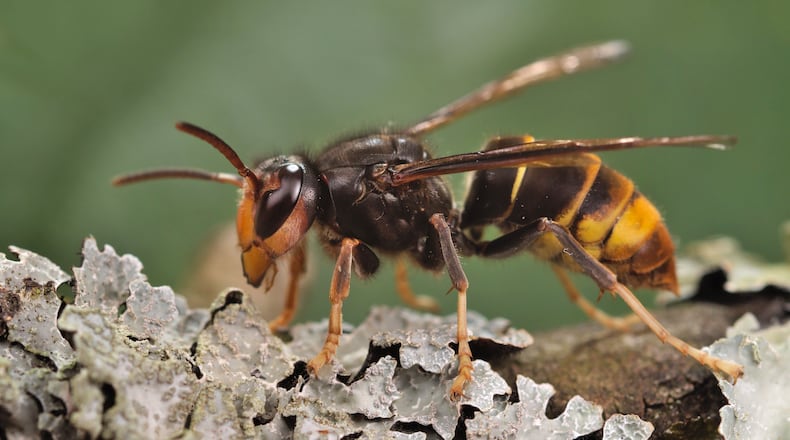Three more nests belonging to a species of invasive, bee-eating hornets have been found and destroyed in the Savannah area, Georgia Department of Agriculture (GDA) officials announced Friday.
The new nests of yellow-legged hornets — a species native to Southeast Asia that preys on honeybees and other pollinators — means there have now been a total of five nests eradicated since the insects were first discovered in Georgia. The first yellow-legged hornet in Georgia was spotted in early August by a beekeeper, marking the first-ever confirmed detection of the species in the wild in the U.S.
If allowed to establish in Georgia, officials have warned that the yellow-legged hornet could pose a grave threat to the state’s agriculture industry. Many of Georgia’s most valuable food crops — like blueberries, watermelons and cantaloupes — rely on pollinators for successful harvests. UGA experts have estimated that Georgia’s pollinator-dependent crops are worth $430 million annually.
All five of the nests found so far have been located around Savannah. The GDA said two of the three new hives were discovered within a mile of each other, high up in pine trees in the town of Thunderbolt. One was found on Oct. 11 and second other a week later on Oct. 18.
The third new nest was spotted on Oct. 25 farther south on Skidaway Island. While it is the first nest found so far on Skidaway, GDA officials said the site was well within their search perimeter and that they have no reason to believe the hornets have ventured outside of the greater Savannah area.
The agency and their partners said they are using several methods to monitor for the hornets and find nests, including electronic tagging and catch-and-release of trapped individuals to visually track their movements. So far, a map provided by the GDA does not show any confirmed yellow-legged hornet sightings beyond Savannah and its suburbs.
The nest discoveries come at a critical time: Queens and males begin mating in the final months of the year, before the queens set off to establish new nests. State officials and experts from the University of Georgia (UGA) have said it is critical to eliminate any remaining hives before the pests start reproducing.
In a release, the GDA said preliminary analyses of two of the new nests did not uncover any signs that they had begun producing queens or reproductive males. Those nests, plus the latest one discovered last week, are being sent to partners at UGA, USDA and the University of Florida for more evaluation, Georgia officials said.
Credit: Danel Solabarrieta
Credit: Danel Solabarrieta
In the meantime, Georgia Agriculture Commissioner Tyler Harper said the state would continue its intensive tracking and trapping campaign. The department has placed 170 traps around Savannah and has two teams on the ground monitoring for new individuals and nests.
“While each nest located and destroyed represents a win for our state and our agriculture industry, we will continue to work overtime to achieve our goal of full eradication,” Harper said in a statement.
Yellow-legged hornets resemble several other species already found in Georgia, but individuals have distinctive yellow tips on the ends of their legs. It is the insects’ aggressive behavior toward honeybees, however, that sets them apart from native species. They are voracious predators known to dive-bomb unsuspecting honeybees as they enter or exit their hives, earning them the nickname “bee hawk.”
The hornets are close relatives of the Northern giant hornet — also known as the “murder hornet” — another invasive species that appeared in Washington state in 2019. While the “murder hornets” have not been officially eradicated, there have been no confirmed sightings in the U.S. since 2021.
The GDA also announced it is launching a biweekly newsletter called the “Yellow-legged Ledger” to keep Georgians informed about the fight against the pests. Interested readers can subscribe here.
What to do if you spot a yellow-legged hornet
- Report possible sightings to the Georgia Department of Agriculture via their online form available at https://agr.georgia.gov/yellow-legged-hornet.
- Take a photograph at a safe distance, if possible.
- Check to ensure the insect is indeed a yellow-legged hornet. A photo gallery of native pollinators and lookalikes can be accessed at www.aphis.usda.gov by searching for “yellow-legged hornet.”
- If you can safely trap the insect alive, state officials say to do so, as the individuals can help experts locate potential nests.
- Send questions or comments to yellow.legged.hornet@agr.georgia.gov
About the Author
Keep Reading
The Latest
Featured



